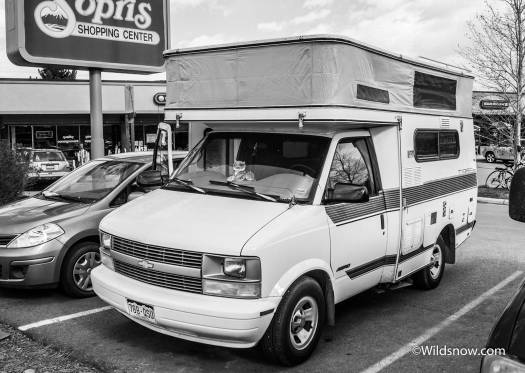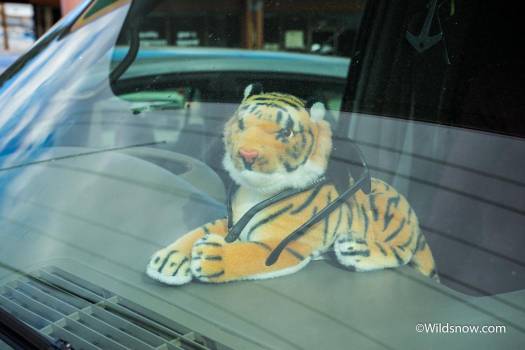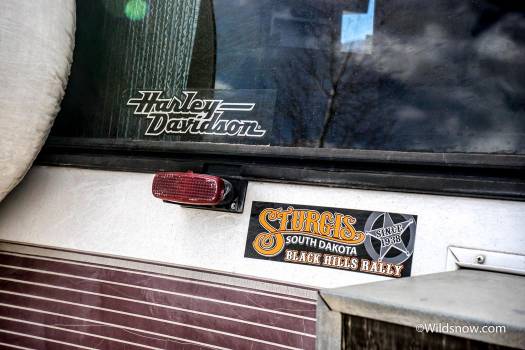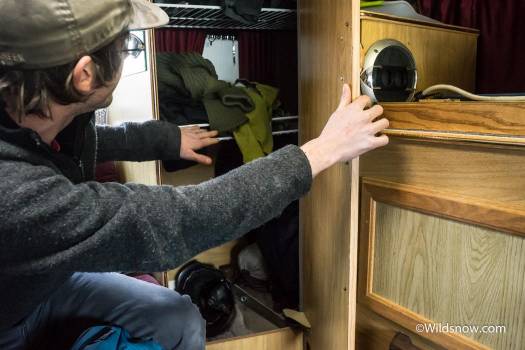Stephen Dilk
Wiser people than I have often observed that the journey is more important than the destination. Whether it’s slogging up the side of a peak or bushwhacking through a jungle wall of scrub oak, the experience of striving to persevere over these hardships provides one with a profound sense of appreciation for the holiness of the moment; while the challenge acts as a crucible washing the subject clean in the purity of the struggle.
In my particular case, while driving a junk-car that grumbled, creaked, screeched, and shuddered like a spacecraft on reentry, my “journey” began and ended when I got out of my car in one piece. Anything that went wrong during the outing seemed small compared to returning to my auto and driving home.
After several such experiences, it was time for an upgrade. Thus, I dropped down the rabbit-hole of researching and buying the optimal skiing and climbing live-in “adventure” vehicle: in my case a 1997 Astro Tiger Provan.
I started by judging the relative limitations and strengths of possible vehicles. Essentially, the unit had to be perennially livable (and in cold temps), yet rugged enough to handle snowy, rough roads and come in at under ten thousand dollars (my total budget).
That, in itself, is not a tough bill to handle, as virtually any car is livable under the correct conditions, but I defined livable as, “the act of being able to stand up in the abode and have running water and heat at all times of the year if so desired.” I saw these features as absolutely critical for maintaining comfort, sanity, and health while skiing and climbing for extended periods of time, yet limiting because those criteria do not leave many choices.
The initial field consisted of a pickup with camper shell, a cargo van with extensive modifications to the exterior and interior like a Sprinter, Econoline, or Delica, or a hippy wagon (read: Vanagon, Toyota 4 x 4 van, VW van).
My next set of criteria reflects my dual existence as a skier and climber. I desired more interior storage space for skis and ski boots (especially to be able to dry boot liners), an ability to clamber into the rear from the front without getting out, and most critical: snow reliability.
Unlike many climbers, gas efficiency is a less critical feature for me; although a consideration, I realized it was an easy trade-off.
Other trade-offs exemplify my winter needs. For example, converted Econolines or Sprinters have the awesome trait of being able to be hidden in plain sight. People living in them always tout their ability to boondock in urban areas because they blend in so well. A rig like the truck with the camper shell is more conspicuous. Personally, however, I envisioned being away from urban areas the majority of time living in the vehicle, so urban camouflage became a low priority.
I was also fortunate to live with a roommate who owned a Toyota truck that had a Four-Wheel camper on back. We took it to the Tetons so I was able to really study the rig. I focus on this set-up because at the time it was at the top of my list. Trucks have the ability to get just about anywhere and with the camper on back it met my livable criteria. (In fact, if you want a 4×4 camper, the classic slide-in on a pre owned 4-wheel-drive truck is still one of the most easily obtainable and more or less affordable ways to go — and super versatile.)
Unfortunately, the biggest limiting factor of these rigs (and VW vans) for me is their price tag. The high costs for a youthful truck and a middle aged camper discouraged me. I felt like I was running too high of a risk getting a truck with 150,000 miles on it and a Reagan-era camper. I began to drift away from the truck camper combo, although with more cash, that would still be my number one choice.
Cargo vans excluding Sprinters are on the other end of the spectrum. A cursory glance at Craigslist will reveal a new supply of vans almost daily. Often, these vans are mechanically sound, but may only exhibit some cosmetic wear. Consequently, it seemed like a great way forward. Internally, vans can be modified in almost any way — time, money, and imagination being the only limiting factors. They are easy to repair, hardy, decent to good in the snow, and can ultimately be uplifted to a proper 4×4 (an expensive move).
For me however, modification seemed like a daunting task. I am woefully inept at basic home repair/skills/design. I also do not own any tools, nor do I have a garage to store the necessary parts and tools.
I assumed I could figure things out as I went along, but did not want to spend my entire summer completing the project when I’d rather go climbing. In other words, motivation must remain high, and focus iron clad. If Orpheus could not manage to save his beloved by merely walking straight ahead for a spell, there was no way I was going to see this potential marathon project through. Thus, modifying a van seemed increasingly less appealing.
Around the time despair began to visit daily, a friend suggested a radical choice. The Astro Tiger built by Provan. He asked, “What is not to like about an Astro van outfitted with a mini camper/RV cabin on the back that has the option to pop up to 6’4”?” To me the answer is not much.
Other technical information enticed me further. When not popped up, the GT will fit in a normal car garage. I learned later that Astro Tiger Provans come in two styles: the GT and the XL. The difference being the GT is the pop-top while the XL is a permanently popped top that is made of fiberglass and has built in cabinetry.
My friend went on to extol more virtues: room to spread out, two beds — one above the cab when the top is popped and the other being the folded out couch, a fully contained living space which includes a propane stove, furnace, three-way refrigerator, hot and cold water, a shower and head, generator, coach battery, and storage space.
The vehicle itself is built on the Chevy Astro van chassis, which comes as a RWD or AWD, and has a V6 Vortec engine. Parts are abundant and cheap and apparently everyone and their grandmother has the know-how to do repairs. To my surprise, after some research, I found that the GT models even get around 20-23 miles per gallon on the highway and around 15-17 in cities.
Lastly, and most importantly for my needs, I found that the added weight on the rear axle allows this van-camper configuration to have decent to great traction in the snow (I could only afford the RWD version).
All sounded great on paper. The only problem was finding one. Obtaining an Astro Tiger is definitely a crux constraint for these vehicles. Due to the cessation of production for the Chevy Astro vans in 2005, Provan (the company that makes Tigers) stopped producing them. Even during peak production, not many of these vehicles hit the road. With a reputation for longevity, people do not readily resell them.
Fortunately for me it was love at first sight. Something about the vehicle struck a chord of rightness in my heart so resounding that I was willing to put forth extreme effort to obtain one. Luckily, after nearly three months of fitful searches and one aborted purchase attempt in Kansas, I bought a 1997 Astro Tiger GT with 77,000 miles on it.
I have learned a few things since buying the rig. One main drawback to owning a fairly unique vehicle such as the Tiger is the complete loss of anonymity and sometimes even privacy. Meeting people out in town, I now always hear “I saw the Tiger on the road” or something similar. Tigers also elicit curiosity, which manifests itself in the form of many knocks on the door from people who want to peek inside.
Despite these unforeseen drawbacks, I am happy to report that the Tiger is performing admirably. I am still working out the kinks of owning a mini RV, but thus far I cannot point out a major flaw that disgusts me. These days, I am actually looking forward to my journeys on the road. In my rig, they can be even more fun than the adventure!
(Having grown up in upstate New York, guest blogger Steve Dilk considers the worst conditions in Colorado to be manna from heaven. What he may lack in skill and style, he makes up for in enthusiasm. When not working, skiing or climbing, you’ll find him moonlighting at Cripple Creek Backcountry in Carbondale, CO.)
Beyond our regular guest bloggers who have their own profiles, some of our one-timers end up being categorized under this generic profile. Once they do a few posts, we build a category. In any case, we sure appreciate ALL the WildSnow guest bloggers!




